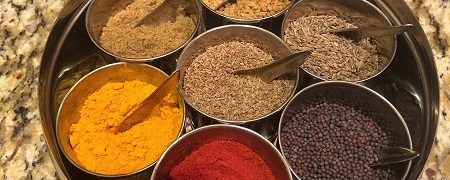Print Pav Bhaji Prep time: 15 mins Cook time: 40 mins Total time: 55 mins Serves: 6 Pav (bread) Bhaji (mixed vegetables) is a street food available all over India. The bhaji should be soft and mashed which you can scoop up with a pav. This recipe uses small quantity of variety of vegetables which is […]
Turiya Patra nu Shaak
Print Turiya Patra nu Shaak Prep time: 15 mins Cook time: 20 mins Total time: 35 mins Serves: 4 Ingredients 2 medium or 1 large turiya (snake gourd, known as Chinese okra) 4 rolls of Patra, cooked or uncooked 3 tablespoons olive oil 1 teaspoon cumin seeds 1 teaspoon ground turmeric ¼ teaspoon chili powder 1 […]
Undhiyu
Print Undhiyu Prep time: 20 mins Cook time: 40 mins Total time: 1 hour Serves: 4 This mixed vegetables recipe is quintessential Gujarati dish. It is a very famous dish from city of Surat in Gujarat. The variety of green beans called papadi used in this recipe are named after the city. The fresh papadi is […]
Baghara Baigan
Print Baghara Baigan Prep time: 15 mins Cook time: 25 mins Total time: 40 mins Serves: 4 This eggplant curry is from city of Hyderabad, Southern part of India (in a state of Telangana), and it is usually served with Biryani. It is made with small purple egg sized eggplants (known as Indian eggplants). Ingredients 1 […]
Vegetable Biryani
Print Vegetable Biryani Prep time: 30 mins Cook time: 1 hour 30 mins Total time: 2 hours Serves: 4 This dish comes from city of Hyderabad (in State of Telangana), Southern part of India.. Ingredients For fried shallots and marinade: 1 lb. shallots, thinly sliced 3 tablespoons ghee or melted butter or canola oil ¼ cup […]
Veg. Thanksgiving 2016
Print Tandoori Cauliflower This delicious recipe of tandoori cauliflower with spiced yogurt by Kelsey Nixon made a great center piece for a vegetarian Thanksgiving. 3.5.3208 Print Spicy Potatoes Prep time: 10 mins Cook time: 25 mins Total time: 35 mins Serves: 8 Ingredients 2 lb. bag of assorted color baby potatoes 1 medium shallot, […]
Stuffed Vegetables
Print Ringal Bataka na Ravaiya Prep time: 15 mins Cook time: 20 mins Total time: 35 mins Serves: 4 The stuffed vegetables are known as Ravaiya or bharelu skaak. Ingredients 4 small ringan (Indian eggplant) 4 small red or yellow bataka (potatoes) 4 tablespoons olive oil 1 teaspoon brown mustard seeds ½ teaspoon cumin seeds ¼ […]
Mutter Paneer
Print Mutter Paneer Prep time: 15 mins Cook time: 15 mins Total time: 30 mins Serves: 4 Ingredients 1 lb. frozen peas (mutter), thawed ½ lb. fried or plain cubed paneer, available in Indian grocery stores 3 tablespoons canola oil or butter 3 teaspoons garlic-ginger paste, available in Indian grocery stores ½ teaspoon ground cumin 1 […]
Palak Paneer
Print Palak Paneer Prep time: 10 mins Cook time: 25 mins Total time: 35 mins Serves: 4 Ingredients 2 lbs. baby spinach (palak) ½ lb. fried or plain cubed paneer 1 medium onion, roughly cut into ½ inch dice 2 garlic cloves, roughly chopped 1 inch piece of ginger, roughly chopped 1 green chili, roughly chopped […]
Choli Muthia nu Shaak
Print Choli Muthia nu Shaak Prep time: 10 mins Cook time: 20 mins Total time: 30 mins Serves: 4 Indian long green beans, called Choli in Gujarati, are not easily available fresh here. You can use frozen choli available in Indian grocery stores or Chinese long beans. Ingredients 1 bag of frozen choli (Indian long green […]
Moola ni Bhaji nu Shaak
Print Moola ni Bhaji nu Shaak Prep time: 10 mins Cook time: 25 mins Total time: 35 mins Serves: 4 Ingredients 2 bundles of radishes with greens (bhaji) or 1 bundle of daikon (moola) with greens 2 tablespoons olive oil 1 teaspoon fenugreek seeds ⅛ teaspoon asafetida 1 tablespoon chopped cilantro, for garnish Flour mixture: ¼ […]
Patra
Print Patra Prep time: 45 mins Cook time: 45 mins Total time: 1 hour 30 mins Serves: 8 servings This recipe is made with taro leaves, which are not easily available in Indian grocery stores. If you find it use it otherwise use collard greens or chard. Ingredients 1 bunch collard greens 2 cups chickpea flour […]
